Penguins might be cute, tuxedo-wearing animals from the southern hemisphere, but there’s a lot more to them than meets the eye.
Once you’ve broken the ice, you’ll notice that they’ve evolved unique adaptations to survive in extreme climates and clever ways to raise their young. In this article, we’ll look at 23 cool facts about penguins that you probably didn’t know, and if you hadn’t guessed by now, there will be plenty of penguin jokes and puns thrown in for good measure.
- 1. There Are 18 Different Types of Penguins
- 2. Not All Penguins Live in Cold Places
- 3. They Are Black and White for Camouflage
- 4. Penguins Originated in Australia and New Zealand
- 5. They Take Lots of 10-Minute Naps Throughout the Night and Day
- 6. They Can Sleep Standing Up and With One Eye Open
- 7. Emperor Penguins Huddle Together for Warmth
- 8. Penguins Are Birds
- 9. Although They Are Warm-Blooded, Their Feet Are Cold
- 10. Some Penguins Grow Yellow Feathers to Be More Attractive
- 11. Penguins Aren’t Loyal to Their Partners and They Can Get Divorced
- 12. Penguins Can Dive As Deep As 500m
- 13. It’s Illegal to Hunt or Kill Penguins
- 14. Penguins Have No Natural Land Predators
- 15. Penguin Eggs Are Clear When Boiled
- 16. Penguins Regurgitate Food For Their Young
- 17. Penguins Leave Their Chicks at a Creche
- 18. They Are Carnivores But They Can’t Taste Meat.
- 19. Penguins Can Drink Salt Water Thanks To a Special Gland
- 20. The Original ‘Penguin’ Was A Great Auk
- 21. Some Penguins Are Endangered
- 22. Penguins Can Be Gay
- 23. Life Expectancy Ranges From 6.5 to 30 years in the wild
1. There Are 18 Different Types of Penguins
Watch the video version here, or scroll down to continue reading the rest of the article:
When most people think of penguins, they are typically imagining a King or Emperor Penguin since these are the biggest and most recognizable.
However, there are 18 different types of penguins recognized by the IUCN. Each species has its own physical characteristics and has adapted its behavior to suit the environment in which it lives.
The smallest penguin is the Little Penguin at just 40cm (16”) tall whilst the largest penguin is the Emperor Penguin which is more than three times as tall at 115cm (45”) and more than thirty times as heavy.
2. Not All Penguins Live in Cold Places
It’s a well-known fact that penguins can live in cold environments such as Antarctica where the largest penguin populations can be found. However, the Antarctic isn’t the only place you’ll find these adaptable sea birds.
Penguins live all across the southern hemisphere including Antarctica, sub-Antarctic islands, South America, Africa, Australia, and New Zealand.
The most northerly penguins are a small colony of Galapagos Penguins which live in the Galapagos Islands, a group of islands that straddle the equator, just off the coast of Ecuador.
3. They Are Black and White for Camouflage
Penguins might look like they are wearing tuxedos, but it’s not because they want to dress smartly. Their black and white color is for camouflage whilst in the ocean.
They use a technique called countershading. If their predators see them from below, their white front blends in with the light coming from the surface waters above. When seen from above, their black back will also blend in with the darkness coming from the deeper waters below that also disguises them1 (source: H.M. Rowland, The Royal Society B Biological Sciences, Issue 364, 2008).
When penguins are first born, penguins will have different color feathers to their parents and in the past have often been mistaken for separate species2 (source: National Geographic). These differences are because penguin chicks are not yet able to swim in the ocean. Immature penguin feathers are not waterproof so they would get too cold and since they can’t go in the ocean anyway, they don’t need the camouflage like their parents.
4. Penguins Originated in Australia and New Zealand
Although we might mostly associate penguins with Antarctica, they actually originated in Australia and New Zealand around 22 million years ago3 (source: J.A. Vianna, et al., Proceedings of the National Academy of Sciences, Vol. 117 (36), 2020).
Since then, many subgroups have diverged from the original penguin, first was the Aptenodytes group which migrated to Antarctica and now includes King Penguins and Emperor Penguins.
When the Drake Passage (the stretch of water between Antarctica and Argentina) opened up, penguins were able to move further across the ocean and more sub-groups formed.
5. They Take Lots of 10-Minute Naps Throughout the Night and Day
Penguins are polyphasic, this means that instead of taking one big block of sleep like humans, they get their sleep as many smaller naps. These naps will typically be less than 10 minutes and can take place throughout the day and night. This is to reduce the risk that predators will sneak up on them.
A study of Emperor Penguins found that they took many 4 – 7.5 minute naps which totaled to 10.7 hours sleep during 24 hours4 (source: S.S. Campbell and I Tobler, Neuroscience & Biobehavioral Reviews, Vol 8, Issue 3, 1984).
6. They Can Sleep Standing Up and With One Eye Open
So we know that penguins take many naps, but how do they sleep? Penguins can sleep on land or in the water. Whilst sleeping in the sea, they will float near the top where their fat will keep them buoyant.
Whilst on land, they will sleep standing up as this reduces their contact with the floor which can be very cold in Antarctica or very hot in places like New Zealand. You can recognize a sleeping penguin because they will tuck their beak behind one of their flippers5 (source: G. Dewasmes, et al., American Journal of Physiology-Regulatory, Integrative and Comparative Physiology, Vol 256:2, 1989), as shown here.
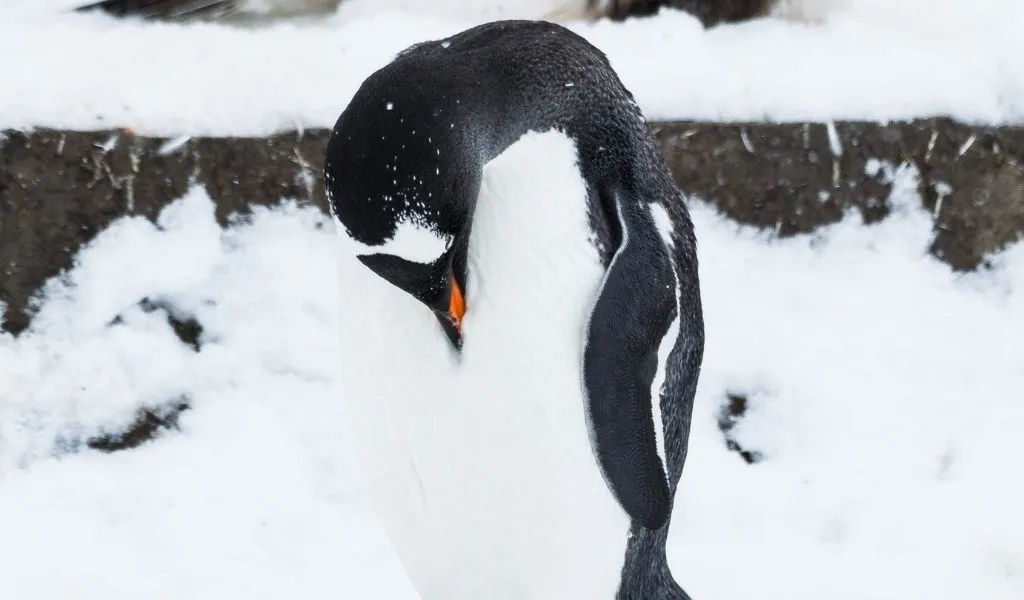
The Humboldt Penguin can sleep with one eye open in order to keep an eye out for predators6 (source: N. Rattenborg, Neuroscience & Biobehavioral Reviews, Vol 24, Issue 8, 2000). This is known as unilateral eye closure and involves resting only half of their brain at one time.
7. Emperor Penguins Huddle Together for Warmth
Among Emperor Penguins, it’s the male who incubates the egg. To keep themselves and their eggs warm in the cold Antarctic winter, the penguins form a large huddle which can be as large as 5,000 birds.
In the huddle, the penguins can be crammed in at 10-12 penguins per square meter, this helps maintain a temperature as warm as 30°C in the center7 (source: S. Moss, Dynasties, 2018), compared to -40°C outside the huddle.
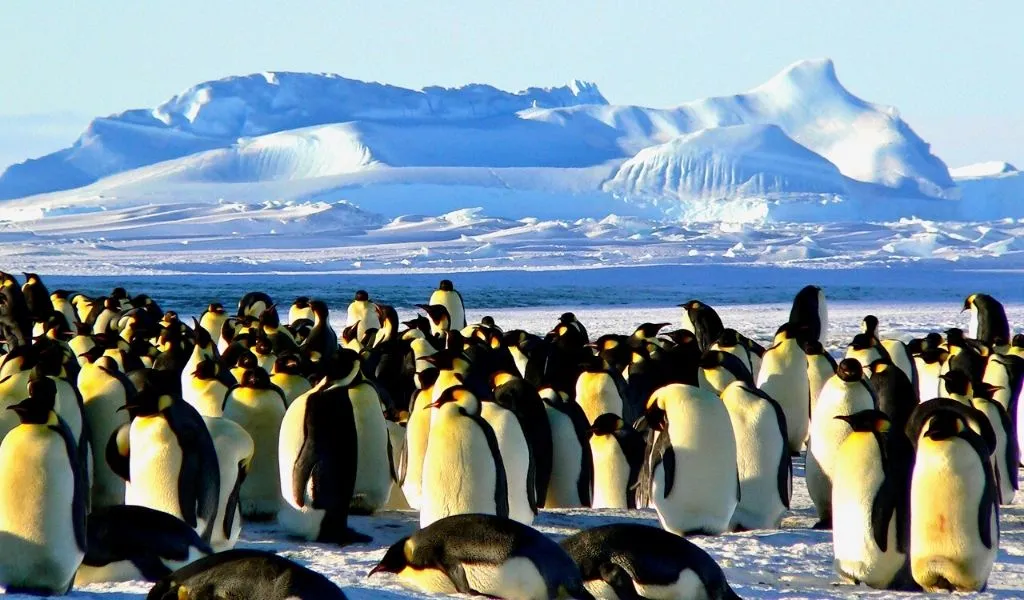
The cold penguins on the outer-side will push their way towards the center where the warmer penguins will move out to allow them in, working together to retain heat and reduce the amount of energy they consume whilst incubating the eggs as they cannot eat during this period.
8. Penguins Are Birds
Although often mistaken for mammals, fish, or even reptiles, penguins are birds that sit within the scientific classification of ‘Aves’ (meaning birds).
Penguins may seem very different from other birds that we know, but they have all the key characteristics of a bird. They are warm-blooded vertebrates, have feathers and forelimbs modified into wings, have a four-chambered heart, and lay hard-shelled eggs.
They are closely related to tube-nosed birds (Procellariiformes) which include albatrosses and petrels.
9. Although They Are Warm-Blooded, Their Feet Are Cold
One of the ways that penguins have adapted to survive in the cold Antarctic environment is by having cold feet which means that they aren’t losing warmth to the cold surface. They do this using a heat exchange process (the scientific name for this is rete tibiotarsale).
Essentially, the warmth from the blood running to their toes is transferred to the cold blood running back up to their body. This means that the blood can still flow to their feet with the required oxygen, but the warmth stays inside their body8 (source: S. Kazas, Journal of Thermal Biology, 2017).
This is just one of the ways penguins survive the cold, other adaptations include tightly packed feathers that trap warm air and a thick layer of fat.
10. Some Penguins Grow Yellow Feathers to Be More Attractive

Although the majority of a penguin’s feathers are black and white, some species also have golden-yellow feathers on the crest of their head or their neck, or orange feathers on their chest.
Penguins with the most extravagant yellow feathers are the most desirable to mates because it demonstrates that they are so healthy that they can forego some of their camouflage show off9 (source: D.B. Thomas, et al., Journal of the Royal Society, Interface Vol. 10, Issue 83, 2013). It’s a bit like having smart clothes and a nice haircut.
If you want to read about an experiment that researchers did with marker pens to discover this, see our full article about the color pallette of penguins.
11. Penguins Aren’t Loyal to Their Partners and They Can Get Divorced
Penguins are monogamous which means they have one partner per breeding season. However, they do not mate for life as many people often assume and many species are only connected to their current breeding partner.
In a study of Humboldt Penguins, researchers found that around 20% of males and 30% of females engaged in extrapair copulation (the scientific way of saying they cheated on their partner). However, this never resulted in additional offspring10 (source: M.K. Schwartz, et al., Behavioral Ecology, Vol. 10, Issue 3, 1999).
When penguins want to choose a different partner for the next breeding cycle, despite their previous partner being alive and present at the breeding ground, this is known as a penguin divorce. The divorce rate among penguins varies significantly between species. For example, Emperor Penguins have a high divorce rate of 85%, whereas up to 92% of African Penguins will stay with the same partner the following cycle11 (source: Penguins: Natural History and Conservation).
12. Penguins Can Dive As Deep As 500m
Penguins spend up to 75% of their lives in the sea and often don’t visit land for months on end, so they are well adapted to water12 (source: S. Moss, Do Birds Have Knees, 2016).
Penguins are excellent swimmers and divers, with streamlined bodies, flippers which they use like propellers, and webbed feet.
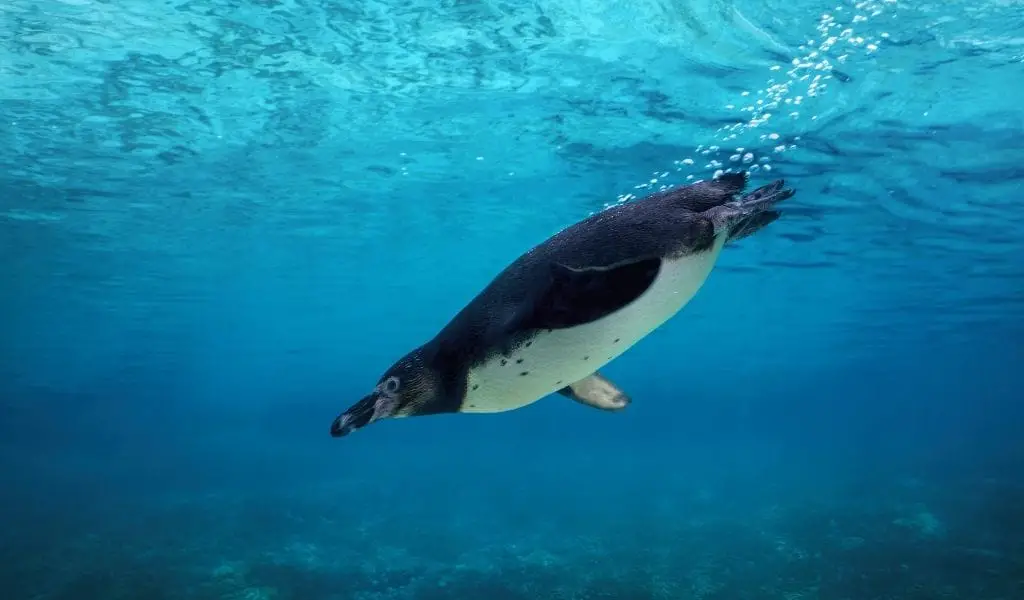
They can also store air beneath their feathers which they can use in the water by fluffing the feathers to release a small airstream of bubbles to push them up and reduce water friction13 (source: J. Davenport, et al, Marine Ecology Progress Series, Vol. 430, 2011).
Emperor Penguins are the deepest divers of all penguin species. They regularly dive to around 300m and can hold their breath for 7 minutes. Although the deepest recorded dive was more than 500m14 (source: Journal of Experimental Biology).
13. It’s Illegal to Hunt or Kill Penguins
Penguins are well protected from hunting with many international and domestic laws.
The best-known legislation that protects penguins is the Antarctic Treaty. This 1959 treaty has been signed by 54 countries around the world and ensures that Antarctica (and anything below 60°S) remains peaceful and cooperative. The environmental protocol of the treaty also ensures protection for all species in this region, including penguins15 (source: Secretariat of the Antarctic Treaty).
Other legislation protects specific species across the world, such as CITES, and most signatories of the Antarctic Treaty have also enforced their own laws at home to protect penguins.
For a summary of these laws and protections, see our full article on can you eat penguins.
14. Penguins Have No Natural Land Predators
As penguins live all across the southern hemisphere, their predators will vary by species.
The main predators of penguins are birds such as skuas and giant petrel, and marine mammals such as seals and whales16 (source: British Antarctic Survey).
Across most of he territory, penguins have no natural land predators, one of the main reasons they have thrived in the southern hemisphere but not the north. However, introduced predators, such as cats and dogs, pose a threat to penguins in some regions.
15. Penguin Eggs Are Clear When Boiled
Although it’s now illegal to eat penguins’ eggs in most countries. We know from old records that they have an interesting look when boiled. Instead of turning white like most bird eggs, the egg white turns clear. This is because they have a different ratio of glycoproteins called ovalbumin and penalalbumin.
Whereas chicken eggs contain only around 0.01% penalalbumin, penguin eggs contain more than 25%. This helps the eggs survive the cold but also gives them a clear color17 (source: D.T. Osuga, et al., Journal of Protein Chemistry, 1983).
16. Penguins Regurgitate Food For Their Young
Both male and female penguins are paternal and contribute to raising their offspring. In fact, the males will even play a significant role in incubating the eggs.
Among Emperor Penguins which breed in the Antarctic winter, the male birds will spend 65-75 days incubating their eggs, holding them on top of their feet whilst they huddle together for warmth18 (source: Australian Antarctic Program). When chicks are born, they are unable to catch food for themselves as their natal down (the baby feathers they are born with) isn’t waterproof so they would get too cold in the water.
Instead, the parents must catch food and bring it back to them. The parents will store the food in their own stomach where it will be ‘refrigerated’ at body temperature and enzymes will prevent it from digesting. Once back with their young, they will regurgitate the food for the chicks to swallow19 (source: Penguins International).
17. Penguins Leave Their Chicks at a Creche
As mentioned in the previous penguin fact, baby penguins cannot regulate their own body temperature until their feathers have thickened into juvenile feathers so they rely on huddling together with their parents to stay warm.
When the parents are off foraging for food at sea, they will leave their chicks along with the other chicks in a large group called a creche. These are usually located near the center of the colony and protect the young from predators, weather, and aggression from other adult penguins20 (source: C. Le Bohec, et al., Animal Behaviour, Vol. 70, No. 3, 2005).
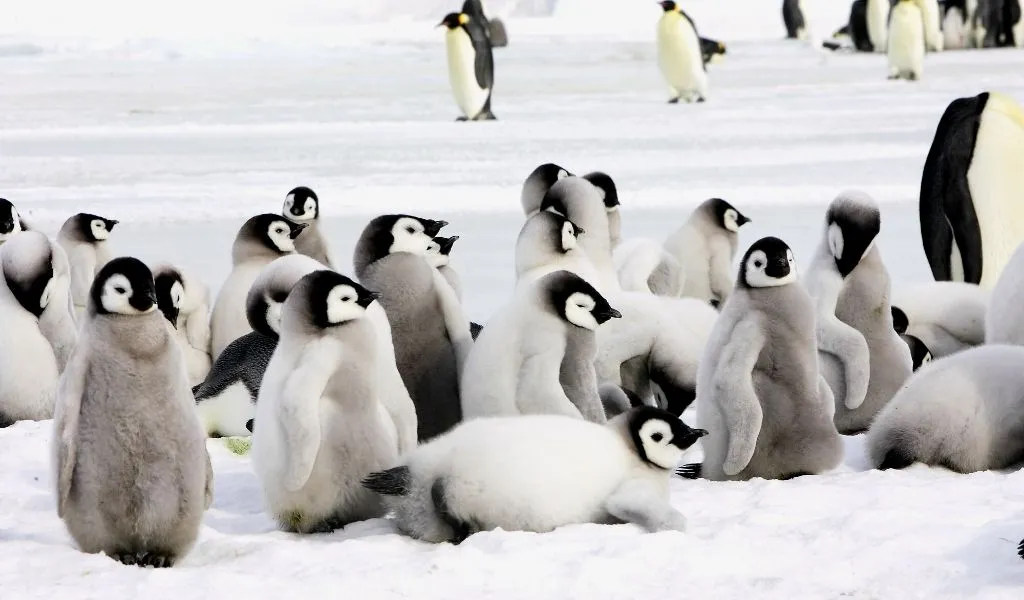
Those at the center of the creche are warmest and safest from predators so there is lots of competition o reach the center, so the weaker chicks will usually be pushed out.
A penguin creche shouldn’t be mistaken for a nursery, it is not for communal care of the chicks. When parents return, they will only feed and care for their own chicks21 (source: Seaworld).
18. They Are Carnivores But They Can’t Taste Meat.
Penguins are carnivores because they eat a diet of mostly meat. The actual diet will vary between species and location, however, it typically includes fish, squid, and small crustaceans such as krill and therefore should be classified as piscivorous.
Interestingly, scientists discovered that penguins only have 2 out of 5 taste receptors compared to us humans, these are sour and salty.
Penguins are unable to taste sweet, bitter, or umami food which is unusual for a carnivore since umami is what gives meat its meaty taste22 (source: H. Zhao, et al., Current Biology, Vol. 25, Issue 4, 2015). However, given that they swallow their food whole, this never seems to be a problem and could be the reason they lost these tastes in the first place.
19. Penguins Can Drink Salt Water Thanks To a Special Gland
Penguins have a salt gland near their eye (often called a superorbital gland) which removes salt from their blood. The salt is then excreted through the nostrils on their beak by sneezing or shaking their heads23 (source: Britannica).
This allows penguins to drink saltwater which they often consume whilst catching their prey. It also allows them to eat prey that is high in salt such as marine invertebrates.
The size of the salt gland is highly related to the type of diet they eat and varies between species. Those species which have a diet with lots of krill and squid will have a larger gland since these animals are very salty, whereas those that eat predominately fish will have a smaller gland24 (source: National Museum of Natural History).
20. The Original ‘Penguin’ Was A Great Auk
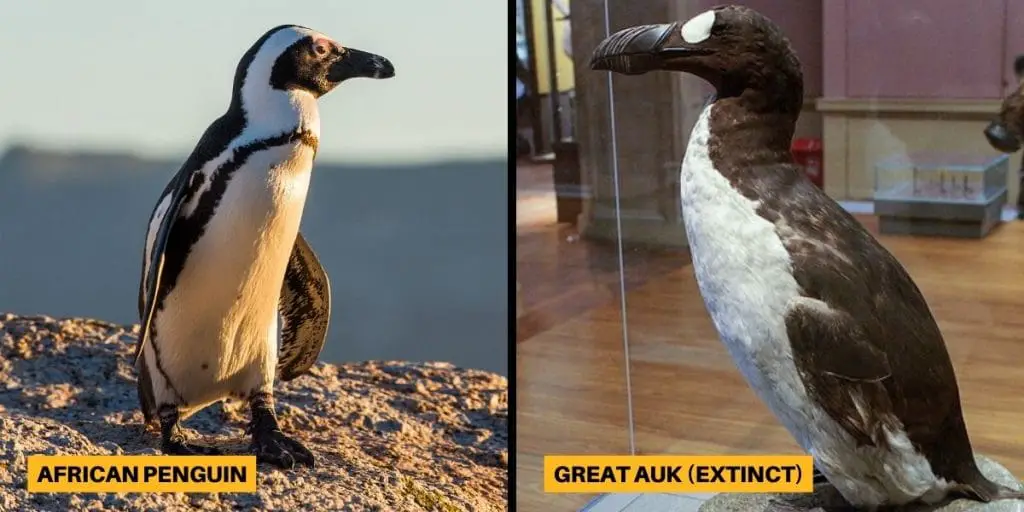
The word penguin is said to originate from the Welsh words ‘pen gwyn’ which translates as ‘white head’.
However, a little-known fact is that the bird they were referring to wasn’t a penguin as we know them today. It was the now-extinct great auk which was also a flightless black and white bird found on White Head Island near Canada25 (source: BBC).
It was later suggested geographically and found genetically that the great auk wasn’t even a close relative to the penguin since they are found at opposite ends of the world.
21. Some Penguins Are Endangered
Out of all 18 species, there are currently 5 species of penguins classified as endangered by the IUCN. These are Yellow-eyed Penguins, Galapagos Penguins, Erect-crested Penguins, African Penguins, and Northern Rockhopper Penguins. A further 7 are vulnerable or near-threatened.
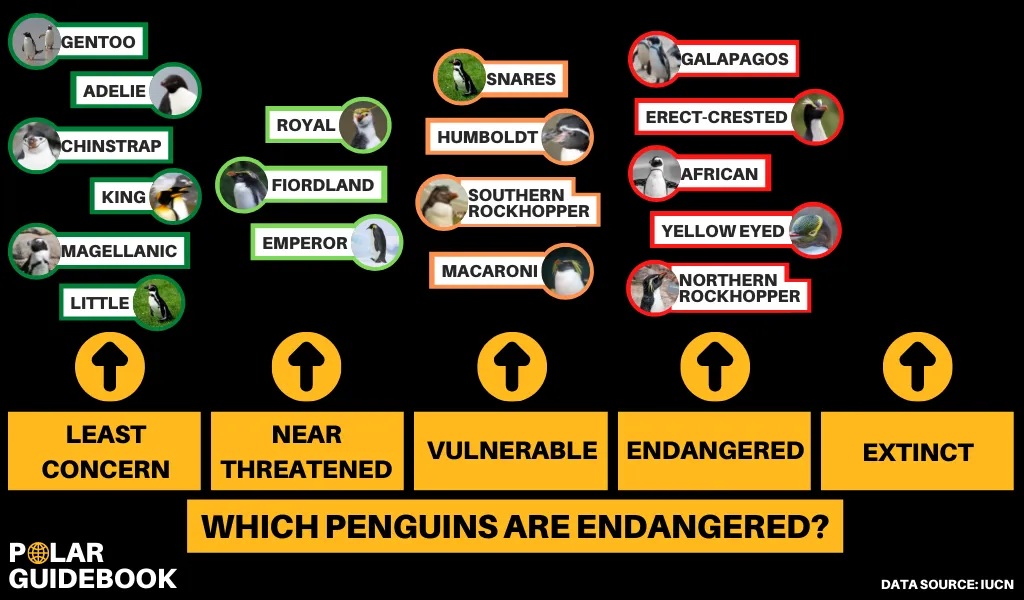
The main reasons for endangerment vary among the different species but can be summarized as climate change, poaching, industrial fishing practices, oil spills, and disease.
See our full articles on why are penguins endangered for more details about each species.
There are 30-31 million penguins in the world according to the latest estimates, and at a total level, they are not at risk of extinction some species are still growing.
22. Penguins Can Be Gay
Penguins can be gay and have been observed engaging in homosexual behavior in the wild and in captivity.
This behavior was first observed among adelie penguins by Dr George Murray Levick R.N in 1910, however, his report called ‘Sexual habits of the Adélie penguin’ was declined for publication because it was considered too shocking for the public at the time26 (source: D.G.D. Russell, et al, Polar Record , Vol. 48 , Issue 4 , 2012 , pp.387-393).
Same-sex penguin couples will often try to steal eggs from heterosexual couples. When given abandoned eggs by zookeepers, gay penguins can hatch and raise young chicks just as well as heterosexual couples.
Gay penguins can be found in zoos and aquariums in China, the United Kingdom, Germany, the United States, and other countries. Out of the 91 Humboldt penguins at London Zoo, there are 3 gay couples; Ronnie and Reggie, Nadja and Zimmer, and Dev and Martin27 (source: Mashable).
Most gay penguins eventually end up in straight partnerships.
23. Life Expectancy Ranges From 6.5 to 30 years in the wild
Our final fact about penguins is that their life expectancy can vary greatly depending upon the species and their environmental conditions. The youngest is the Little Penguin, found in Australia and New Zealand, which only live to about 6.5 years on average28 (source: P. Dan, et al., Marine Ornithology).
Meanwhile, the Magellanic Penguin can live to a ripe old age of 30 years, making it one of the few bird species that exceed its predicted lifespan based on its weight29 (source: J.A. Cerchiara University of Washington).
However, for most species, the average lifespan of a penguin in the wild is between 15-20 years.

![You are currently viewing 23 Facts About Penguins [Some Might Surprise You]](https://polarguidebook.com/wp-content/uploads/2022/02/facts-about-penguins.jpg)
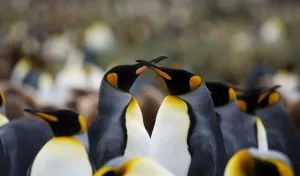
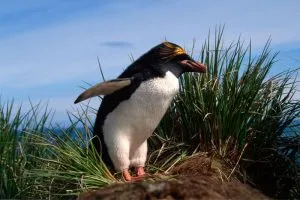
![Read more about the article How Big Are Penguins? [Height & Weight of Every Species]](https://polarguidebook.com/wp-content/uploads/2022/02/how-big-are-penguins-300x176.jpg)